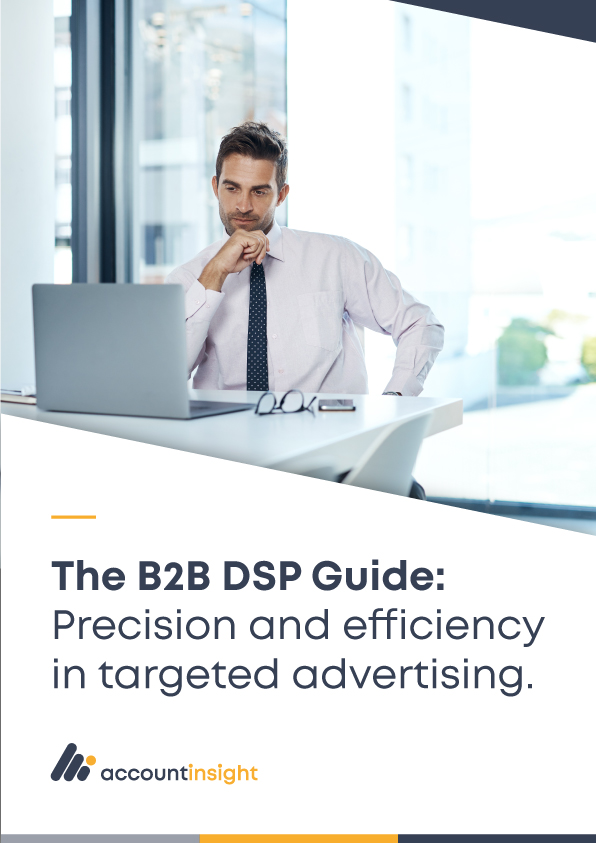Ad Tech & Programmatic Basics
- DSP (Demand-Side Platform): A technology platform that allows advertisers to buy digital ad inventory across multiple ad exchanges via a single interface, often using real-time bidding.
- Ad Exchange: A digital marketplace where advertisers and publishers transact on ad inventory in real time.
- RTB (Real-Time Bidding): An auction-based protocol enabling ad inventory to be bought and sold on a per-impression basis, in milliseconds.
- Impression: A single instance of an ad being served to a user.
- Click: An interaction where a user selects an ad to visit the advertiser’s site or landing page.
- Programmatic Advertising: Automated process of buying and selling ad inventory using data and algorithms to target audiences.
B2B Targeting & Measurement
- Account-Based Marketing (ABM): A B2B marketing strategy focusing on engaging specific target accounts rather than broad segments.
- Company IP Targeting: Serving ads to users based on their corporate IP address to ensure the right company is targeted.
- Intent Data: Behavioral data that indicates a company’s interest in a product or solution.
- Firmographic Data: Company-related data such as industry, size, revenue, used for segmentation and targeting in B2B.
- Buyer Journey: The stages a business decision-maker goes through from awareness to decision.
- Engagement Metrics: Indicators like viewability, clicks, that measure how users interact with B2B ads.
Fraud Prevention & Verification
- Ad Fraud: Deceptive practices like fake clicks or impressions designed to generate revenue without genuine human engagement.
- Click Fraud: Fraudulent clicks on ads, often generated by bots or malicious actors, skewing campaign metrics.. Invalid Traffic (IVT): Traffic that does not represent genuine user intent, such as bots, spiders, or accidental clicks.
- Bot: Automated scripts or programs that simulate user activity, commonly used in ad fraud.
- Anomaly Detection: Techniques used to detect patterns or behaviors in data that deviate from the norm, useful in identifying fraud.
- IP Monitoring: Tracking IP activity to detect suspicious patterns or fraudulent behaviors.
- IP Frequency Management: Limiting the number of impressions or interactions per IP address to ensure fair and human-like exposure.
- Brand Safety: Practices ensuring ads do not appear alongside harmful, inappropriate, or brand-damaging content.
- Third-Party Verification: Independent auditing of ad performance, placement, and metrics to ensure campaign transparency.
- Independent Industry Certification: Validations from third parties that confirm adherence to ad industry standards (e.g., TCF accreditation).
Campaign Optimization & Strategy
- Audience Segmentation: Dividing a target audience into subgroups based on specific criteria such as firmographics or behaviors.
- Frequency Capping: Setting limits on how often a specific user or company sees an ad to avoid fatigue.
- Attribution: The process of identifying which touchpoints or ads contributed to a conversion or desired action.. Viewability: A metric indicating whether an ad had the opportunity to be seen by a user.
- Bid Optimization: Dynamically adjusting bid focus based on company value, time of day, media type, or historical campaign performance to maximize performance.
- Creative Optimization: Testing and refining ad creatives (e.g., messaging, images, CTAs) to improve engagement, often with personalization for different roles or industries.
- Placement Optimization: Choosing optimal ad placements based on contextual relevance, past performance, and avoiding low-quality or fraudulent inventory.
- Time-Based Targeting: Scheduling campaigns during the business hours of your target accounts and pausing during low-engagement periods like weekends or holidays.
- Budget Allocation & Pacing: Adjusting budget distribution across time, channels, and audience segments to focus spend where it drives the highest impact.
- KPI Tracking & Reporting: Monitoring key performance indicators such as impressions, clicks, conversions, and engaged accounts to guide real-time campaign adjustments.
- Suppression Lists: Excluding specific companies, customers, competitors, or internal traffic from campaigns to avoid wasted impressions and budget.







